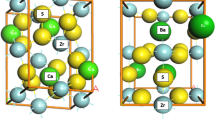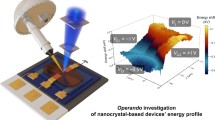Abstract
We present a first-principles investigation on the optical absorption of tungsten trioxide, an electrochromic material. Using state-of-the-art techniques, the absorption spectra are calculated for the cubic, monoclinic, and amorphous phases. For both crystalline and disordered structures, doping induces strong absorption in the infrared. Absorption in the visible range increases with the degree of structural distortion; the absorption coefficient in the blue exceeds 103 cm−1 at doping levels above 1020 cm−3 in the monoclinic phase. Increased disorder in disordered structures significantly enhances the visible-range absorption. We identify the microscopic mechanism as optical absorption originating at conduction-band-derived states that are filled by doping.



Similar content being viewed by others
References
R.J. Mortimer: Electrochromic materials. Annu. Rev. Mater. Res. 41, 241 (2011).
C.J.W. Ng: Synthesis of Tungsten Oxide for Solar Energy Conversion and Water Splitting Applications. Ph.D. Thesis, The University of New South Wales, 2012.
B. Ingham, S. Hendy, S. Chong, and J. Tallon: Density-functional studies of tungsten trioxide, tungsten bronzes, and related systems. Phys. Rev. B 72, 075109 (2005).
Y. Xue, Y. Zhang and P. Zhang: Theory of the color change of NaxWO3 as a function of Na-charge doping. Phys. Rev. B 79, 205113 (2009).
F. Wang, C. Di Valentin, and G. Pacchioni: Semiconductor-to-metal transition in WO3−x: nature of the oxygen vacancy. Phys. Rev. B 84, 073103 (2011).
O.F. Schirmer, V. Wittwer, G. Baur, and G. Brandt: Dependence of WO3 electrochromic absorption on crystallinity. J. Electrochem. Soc. Solid-State Sci. Technol. 124, 749 (1977).
C.G. Granqvist: Electrochromic tungsten oxide films: review of progress 1993-1998. Sol. Energy Mater. Sol. Cells 60, 201 (2000).
R.B. Goldner, P. Norton, K. Wong, G. Foley, E.L. Goldner, G. Seward, and R. Chapman: Further evidence for free electrons as dominating the behavior of electrochromic polycrystalline WO3 films. Appl. Phys. Lett. 47, 536 (1985).
D.H. Mendelsohn and R.B. Goldner: Ellipsometry measurements as direct evidence of the Drude model for polycrystalline electrochromic WO3 films. J. Electrochem. Soc. 131, 857 (1984).
A. Deneuville and P. Gerard: Influence of substoichiometry, hydrogen content and crystallinity on the optical and electrical properties of HxWOy thin films. J. Electron. Mater. 7, 559 (1978).
L. Berggren, J. Ederth, and G.A. Niklasson: Electrical conductivity as a function of temperature in amorphous lithium tungsten oxide. Sol. Energy Mater. Sol. Cells 84, 329 (2004).
R.B. Goldner, D.H. Mendelsohn, J. Alexander, W.R. Henderson, D. Fitzpatrick, T.E. Haas, H.H. Sample, R.D. Rauh, M.A. Parker, and T.L. Rose: High near-infrared reflectivity modulation with polycrystalline electrochromic WO3 films. Appl. Phys. Lett. 43, 1093 (1983).
J.M. Berak and M.J. Sienko: Effect of oxygen-deficiency on electrical transport properties of tungsten trioxide crystals. J. Solid State Chem. 2, 109 (1970).
W. Wang, A. Janotti, and C.G. Van de Walle: Role of oxygen vacancies in crystalline WO3. J. Mater. Chem. C 4, 6641 (2016).
Y. Ping, D. Rocca, and G. Galli: Optical properties of tungsten trioxide from first-principles calculations. Phys. Rev. B 87, 165203 (2013).
H. Peelaers, E. Kioupakis, and C.G. Van de Walle: Fundamental limits on optical transparency of transparent conducting oxides: Free-carrier absorption in SnO2. Appl. Phys. Lett. 100, 011914 (2012).
H. Peelaers and C.G. Van de Walle: Sub-band-gap absorption in Ga2O3. Appl. Phys. Lett. 111, 182104 (2017).
H. Peelaers, D. Steiauf, J.B. Varley, A. Janotti, and C.G. Van de Walle: (InxGa1−x)2O3 alloys for transparent electronics. Phys. Rev. B 92, 085206 (2015).
J.R. Yates, X. Wang, D. Vanderbilt, and I. Souza: Spectral and Fermi surface properties from Wannier interpolation. Phys. Rev. B 75, 195121 (2007).
N. Marzari, A.A. Mostofi, J.R. Yates, I. Souza, and D. Vanderbilt: Maximally localized Wannier functions: theory and applications. Rev. Mod. Phys. 84, 1419 (2012).
G. Kresse and J. Furthmüller: Efficient iterative schemes for ab initio total-energy calculations using a plane-wave basis set. Phys. Rev. B 54, 11169 (1996).
G. Kresse and J. Furthmüller: Efficiency of ab-initio total energy calculations for metals and semiconductors using a plane-wave basis set. Comput. Mater. Sci. 6, 15 (1996).
J. Heyd, G.E. Scuseria, and M. Ernzerhof: Erratum: hybrid functionals based on a screened Coulomb potential [J. Chem. Phys. 118, 8207 (2003)]. J. Chem. Phys. 124, 219906 (2006).
J. Perdew, K. Burke, and M. Ernzerhof: Generalized gradient approximation made simple. Phys. Rev. Lett. 77, 3865 (1996).
G.A. de Wijs and R.A. de Groot: Structure and electronic properties of amorphous WO3. Phys. Rev. B 60, 16463 (1999).
W. Wang, A. Janotti, and C.G. Van de Walle: Phase transformations upon doping in WO3. J. Chem. Phys. 146, 214504 (2017).
D. Lynch, R. Rosei, J. Weaver, and C. Olson: The optical properties of some alkali metal tungsten bronzes from 0.1 to 38 eV. J. Solid State Chem. 8, 242 (1973).
R.-T. Wen, C.G. Granqvist, and G.A. Niklasson: Eliminating degradation and uncovering ion-trapping dynamics in electrochromic WO3 thin films. Nat. Mater. 14, 996 (2015).
S.-H. Lee, R. Deshpande, P.A. Parilla, K.M. Jones, B. To, A.H. Mahan, and A.C. Dillon: Crystalline WO3 nanoparticles for highly improved electrochromic applications. Adv. Mater. 18, 763 (2006).
N. Bondarenko, O. Eriksson, and N.V. Skorodumova: Polaron mobility in oxygen-deficient and lithium-doped tungsten trioxide. Phys. Rev. B 92, 165119 (2015).
Acknowledgments
The authors thank A. Janotti, K. Krishnaswamy, S. J. Allen, and M. McCluskey for fruitful discussions. This work was supported by the US Department of Energy, Office of Science, Basic Energy Sciences, under Award No. DE-FG02-07ER46434. W. W. acknowledges this material is based upon the work supported by the National Science Foundation (NSF) Graduate Research Fellowship under Grant No. DGE 1144085. Computational resources were provided by the Center for Scientific Computing at the CNSI and MRL: an NSF MRSEC (DMR-1720256) and NSF CNS-0960316; the Extreme Science and Engineering Discovery Environment (XSEDE), which is supported by NSF Grant No. ACI-1548562; and in part by an ONR grant and computer time from the DOD High Performance Computing Modernization Program at the AFRL DSRC and ERDC DSRC under Project No. ONRDC36953418.
Author information
Authors and Affiliations
Corresponding author
Supplementary material
Supplementary material
The supplementary material for this article can be found at {rs|https://doi.org/10.1557/mrc.2018.115|url|}.
Rights and permissions
About this article
Cite this article
Wang, W., Peelaers, H., Shen, JX. et al. Carrier-induced absorption as a mechanism for electrochromism in tungsten trioxide. MRS Communications 8, 926–931 (2018). https://doi.org/10.1557/mrc.2018.115
Received:
Accepted:
Published:
Issue Date:
DOI: https://doi.org/10.1557/mrc.2018.115




